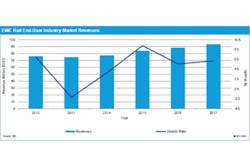Report: Russia suicide bombings shows need for increased rail security measures
A pair of suicide bombings that occurred earlier this week in Volgograd, Russia, have stoked security fears across the country just weeks ahead of the 2014 Winter Olympics that are scheduled to be held in Sochi in February. The bombings, which targeted a bus and rail station, claimed the lives of more than 30 people.
According to market research firm IHS, the bombings have refocused attention on the vulnerabilities of mass transit and rail infrastructure in particular. A recent report from the firm found that purchases of explosives, weapons and contraband (EWC) detection equipment at rail stations worldwide is expected to increase by 3.3 percent in 2014 and 8.8 percent in 2015. A large portion of this growth is expected to be driven by rail expansion projects in Asia.
“Rail travel varies greatly by city, country, and region giving way to varying degrees of security. Unlike air travel, where all passengers and baggage is scanned for EWC, rail travel is not conducive to the same type of security measures. First, many passenger use rail services as their primary mode of transportation and depend on the easy access and convenience that rail transportation offers. Second, many rail stations have higher passenger volumes than airports. For example, in 2013 Atlanta’s Hartsfield-Jackson International Airport had 71.1 million passengers, whereas Tokyo’s Shinjuku Station had 1.26 billion passengers,” noted Jared Bickenbach, analyst for access control, fire and security at IHS.
Ahead of the Sochi games, Bickenbach said that NATO and Russia started work on the Stand-Off Detection of Explosives (STANDEX) system, which was tested at several European rail stations and is expected to be deployed during the 2014 Winter Olympics.
“Overall, the use of explosives detection equipment remains limited at rail stations; however, this is beginning to change as attacks on rail infrastructure continue, added Bickenbach. “The developments of new technologies that meet the unique security needs of the rail industry are expected to drive future growth in the market.”
About the Author
Staff Reports
Editorial and news reports authored by the media team from Cygnus Security Media, including SecurityInfoWatch.com, Security Technology Executive magazine and Security Dealer & Integrator (SD&I) magazine.
